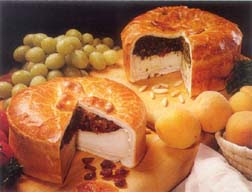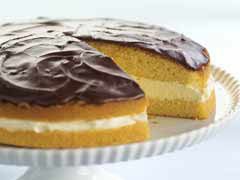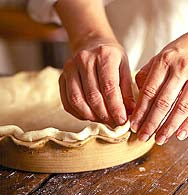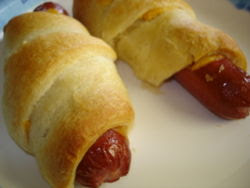I'm sorry, Becky, but you couldn't be more wrong. Allow me to show you the error of your ways.
From
Answers.com:Even into the nineteenth century, the pocket pie in its most ancient meaning lingered on alongside the newer forms in both demotic speech and literature, especially in cookery books of a highly colloquial nature. The unifying principle was that they were considered finger food during a period of English cookery predating the introduction of forks—quite literally something broken or cut into pieces. Indeed, this idea of eating with the hands has persisted for a very long time and is still preserved in such American creations as the Pennsylvania Dutch shoofly pie, a breakfast cake baked in a pie shell and meant to be sliced, held in the hand, and dipped into strong coffee.
This marriage of very different types of pies under the umbrella of one term is further linguistic evidence that the turnover shape was indeed the oldest type and that the English language did not have a wide range of indigenous terminologies to accommodate the newer forms. It is also evidence that the transition from one form to the next was sometimes gradual, especially in the countryside. Food historians generally concur that there is a definite genealogical link between the ancient pie and its modern two-crust descendant, although there is no firm agreement as to how this transition took place. There are several possible avenues of evolution. The shallow dish or saucer pie and the deep dish or potpie offer two theoretical possibilities.
So a turnover-type dish is not only pie, it is the FIRST PIE. That makes it more pie than any of the graham-cracker crust FAKERS. But "wait," you say, "a turnover is only rolled dough also." Not true. According to
Wikipedia, turnovers can have either short or "puff pastry dough."
A pie is any non-dough food baked into and with a dough crust, of any type. Filled croissant, pie. Shepherd's pie, not a pie. Any "pie" with graham cracker crust, not a pie. Pigs in a blanket,
PIE!!!
Also, baked ravioli
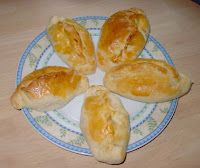 I've been eating pierogi for a while now and I never would have thought to call them "pies." After all, I (and most people--"people" being Americans) boil or fry them, right? Turns out that's because I wasn't making them from freakin' scratch like these crazy Russians. All of a sudden it makes sense. Hello, PIErogi! Duh.
I've been eating pierogi for a while now and I never would have thought to call them "pies." After all, I (and most people--"people" being Americans) boil or fry them, right? Turns out that's because I wasn't making them from freakin' scratch like these crazy Russians. All of a sudden it makes sense. Hello, PIErogi! Duh.